Welcome to the home of the great Indian one-horned rhinoceroses. The idea of going to the infamous Kaziranga National Park itself was like a golden ticket to me. As it was a name familiar to many among us since school days itself, it held immense admiration to me. Familiarised for the rightful reasons that too.
Conserving a good share of the Indian wildlife, among which, are the few species that are under severe threat and are listed under the Vulnerable Species on the IUCN Red List.
The 430 square kilometre park is situated on the southern banks of the Brahmaputra River in Assam.
Conferred as a World UNESCO Heritage Site, the park is known to house approximately 70% of the world’s One-horned rhino population and is one of the largest tiger reserves at their highest density existence.
A trip to this exotic homeland of Indian wildlife is something that’s essential to understand our land better, and the life living within it even better.
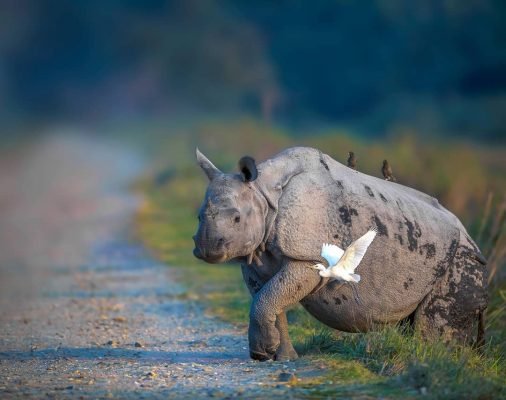
Table of Contents
Colonial backdrop
The idea that placed the foundation stone for this park was in the pre-independence period. Mary Curzon, the wife of the Viceroy Lord Curzon, had visited the area and was distressed on not being able to spot any rhinos.
She put forth a recommendation regarding necessary measures to be taken in order to protect the species.
In 1908, after a series of meetings and surveys, the Kaziranga Reserve forest within an area of 90 sq was created. Demarcated around the edges of Eastern Himalayan biodiversity hotspots – Golaghat and Nagaon, protection of the vulnerable species was ensured in their natural habitat.
Along with this she also made sure that the floral species was equally treasured. Even centuries later this idea is very much treasured in the forms of myriad kinds of flora.
When to Visit Kaziranga National Park
The ideal time to visit the park would be between the months of November to April. Winters in Assam can get pretty chilly, but for those who love a cold breeze, the month of December would be perfect for a visit to Kaziranga. I had chosen to visit the park in the mid-week of April. It is a lot hotter, but this is the time you’d be able to spot a lot of animals grazing around and drinking water from the banks of the Brahmaputra. Not going to lie, it gave me the feeling like I’m living in one of the most magical fables.
The authorities cut the access to the park during the monsoon season, as the Brahmaputra river may get flooded and make the travel inconvenient.
To avoid this scenario travelling during the months of June to August is prohibited. The month of May experiences some rainfall, and still would not be the most ideal period to visit.
How to Get to Kaziranga National Park
- By air
The nearest airports to the park are the Guwahati International Airport and Jorhat Airport.
Among the two, Jorhat is relatively closer at a distance of 97 km. There are also frequent public transport facilities available at Jorhat, so reaching the park or your stay wouldn’t be much of a chaotic task.
Lokpriya Gopinath Bordoloi International Airport in Guwahati opts mostly as it has frequent flights connecting both domestically and internationally. From here, the Paltan Bazar bus stand is at a mere distance of 23 km from where you could find direct bus services to the park. In case this seems inconvenient, there are also numerous cab services that can be availed as well.
- By Train
Furkating station, located 96 km from the park, has well-connected networks from Delhi, Kolkata, Guwahati and so on.
The Jorhat railway station and Guwahati station are farther away than Furkating with a distance beyond 100-200 km.
Since the park is located right in the midpoint on the route to Tezpur and Jorhat, it’s easier to reach the place by cabs and other means of transport.
- By Road
The park is connected via NH37 to many of the major cities including Guwahati, Jorhat, Golaghat, Shivsagar and so on.
Guwahati to Kaziranga – 176 km
Shivsagar to Kaziranga – 170 km
Jorhat to Kaziranga – 113 km
Golaghat to Kaziranga – 89 km
There are also well-maintained road links to Kolkata, Delhi, Patna and so on.
There are very frequent public transport services available to the town of Kohora. In intervals between the state transport bus timings, there’s private run buses, minibuses and cabs that go en route.
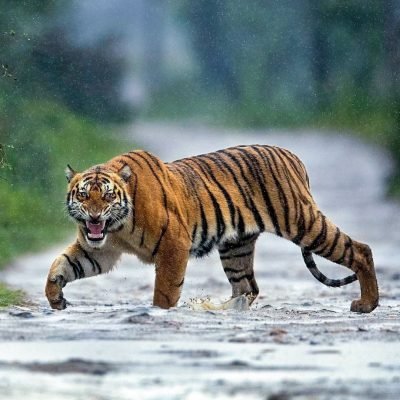
Where to Stay
Tailored to fit your preferences, there are numerous stay options around Kaziranga park. Within the near vicinity itself, there’s resorts, hotels, lodges and camps that have just so much to offer.
They vary in terms of budget and facilities but are at a walkable distance from the park. So based on these factors you can research upon the accommodation and select one that best suits your requirements of budget and amenities.
Pre-booking is the best option as you can avoid the hustle regarding the stay facilities once you reach the park.
They also come along with attractions such as Jeep Safari, trekking, tea garden visit and exploring the tribal villages.
Entering the Kaziranga National Park
Opening in the early hours of 7’30 am, the park offers a tour around it till 4’00 pm. The entry fee is Rs. 50/- per head for Indians, and there are separate fees for the jeep safari, photography and so on.
The fee ranges from Rs. 3,800 to Rs. 5000 for Jeep safari, and again, the price varies for Indians and for foreigners. The rates are quite higher for foreigners in terms of entry and other related fees.
One thing I can assuredly tell you is that the fee is barely an amount to the kind of scenic visual treat Kaziranga arranges for the visitors.
Things to Do in Kaziranga National Park
I couldn’t realise the time passing by while I was at the park and long after I had left the place also the time spent over there stuck with me.
Kaziranga is a full-fledged package with numerous experiences and adventures around it.
- Refresh at the Kakochang falls
- Exoticness of the orchid biodiversity park
- Antique beauty of the National museum
- The unmatched game drive experience
- Spellbinding Culture of Assam
1. Kakochang Waterfalls
Distance: 48 km
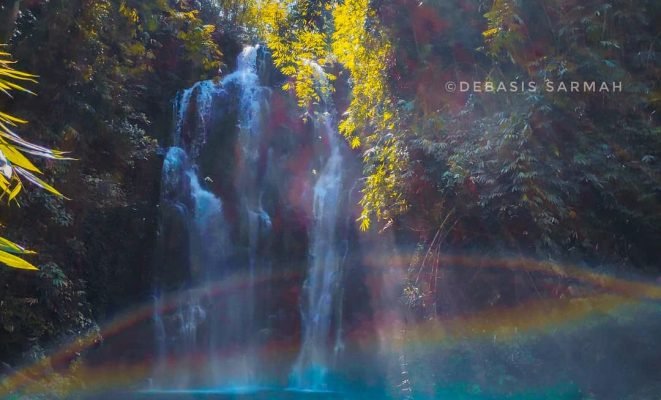
Located around Bokakhat of Jorhat, Kakochang waterfall is a well-known tourist attraction near Kaziranga. The 4 km trek up to the falls is beyond magical with the dewy elephant grass below and the cloudy skies above. Kakochang looked like the converging point of the skies and the grasslands, almost like the heavens stepping down to Earth.
The falls aren’t as heavy in the summer season and you can step down into the refreshing waters.
If you’re mapping your route from Jorhat to Kaziranga, it becomes easier to make a halt at this place and then leave for the park.
It is also a very famous eat out spot with several stalls and cafeterias selling the local cuisine and street food.
The post-monsoon period feels like an out of the world sight. The rainfall adds on to the glimmering threads of water plummeting from the falls.
Other attractions you can notice from this point are the historical ruins of Numaligarh and Deoparbat.
2. Kaziranga Orchid and Biodiversity Park
Distance: 26 km

There’s an infamous Orchid park of Kaziranga at Durgapur and one closer to its heart at Hatikhuli. Established in 2015, this park is the contemporary add on to the age-old ideas of conserving the flora. With the greenhouses sheltering almost 600 species of orchids, the park has the largest collection of exotic and native orchids in India.
Most of these collections are brought in from all over the northeastern parts of India.
Apart from the greenhouses, you can go around on a peaceful nature walk and explore the rich biodiversity of the beautiful seven sisters of India.
There is a cactus park not far away from here which grows above 300 species of cacti. Cacti is a quintessential attribute in the medicines and food of the North Easterns. Walking around the park, I was offered a certain plant called stevia which is used as a natural sweetener in their diets.
Sweeter than table sugar, yet consists very fewer calories. It was among those few times I wouldn’t have minded switching to healthier and organic options.
This place is a feather added to the crown of Kaziranga.
3.Assam State Museum
Distance: 175 km
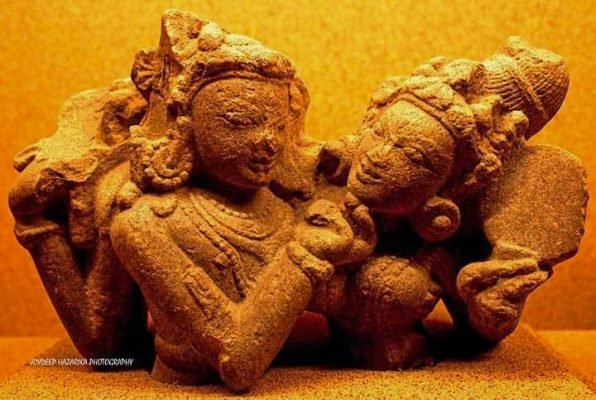
Established during the pre-independence years by the Kamarupa Anusandhan Samiti (Assam research society), the State Museum is one of the most treasured gems of North East India.
Set amidst the 1940s, it’s a mesmerising collection of the ancient sculptures, handicrafts and other antiquities.
Developed under the presidency of Kanklal Baruah, the state had taken up the authority to develop the museum and brought it under their initiatives in 1953. The true essence of tribal culture and traditions are the highlights of this museum. Information regarding each of the 97 enlisted tribes and their lifestyles are narrated through every bit of material kept carefully within glass cases and barricades.
The museum is at Guwahati and can be easily accessed through direct transportation facilities arranged by the State transport.
It attracts a lot of history buffs and enthusiasts every day, and there’s uncalled respect for the Assamese culture that lingers within the air here.
Another attraction nearby is the bamboo technology park not more than 3 km from the museum.
4. Experience the Local Culture
Distance: Within the park

Right around the several tourist spots, you can find Assamese people celebrating their extensive culture in everything they do.
To begin the day, from a humble stall I was offered a warm plate of thali with almost 30 dishes including rice cooked to perfection and gravies with flavourful crushed spices and cream. Wrapping up the day in the same style, there was a delightful performance of the traditional dance Bihu with people dressed in shades of beige and red.
At the Orchid and Bio-diversity park, I noticed few localites exhibiting the craftsmanship of the Bodo tribe with pride. I brought a shawl from them, for which I was given a warm smile and a welcoming invitation to their humble settlements across the park.
Inside the park, there’s a small Pavillion with a stage set for the cultural performances that’d happen around evening.
One among them is the infamous Bamboo dance, where men hold bamboo poles to the ground with a rhythmic pace while women dance between them to the music.
5. Game Drive
Distance: Within the park
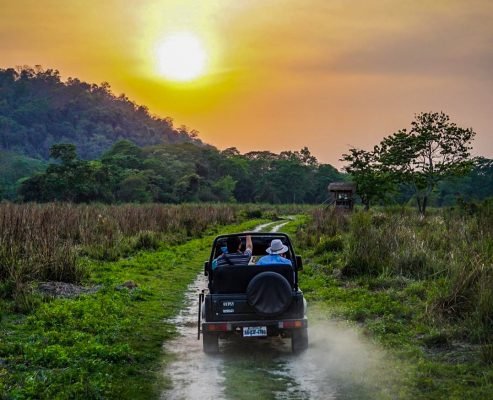
Undoubtedly one of the main highlights of the park is the jeep safari. Taking you around the dirt tracks of the park, the drive can be booked either on the spot or online pre-booking.
Divided into four zones, Central, Eastern, Western and Ghorakati range, the entry formalities will be taken care of at the respective entry points.
The safari costs for the ranges differ from Rs 3,800 to Rs 5,000. I was provided with the information regarding the zones via a brochure and the guides offering the safari around.
Select your preferred range carefully as each of them have a specific concentration of animals and fascinating features. Bird watchers might be more interested in the Eastern range, while the Western range is home to an increased number of rhinos. Apart from these, you would also be able to spot the hawk-eyed eagles, Bengal monitor lizards, roof turtles, Asian water buffaloes, Rhesus macaque and so much more.
There are two different shifts, one in the morning and the other, in the afternoon hours. The Kohora range particularly interested me and the package came within the budget of 3,800 Rs.
Also known as the Central Zone, the Kohora provided the most beautiful sight of elephants and rhinoceroses wallowing around as the first few rays of the sun hit the grass fields.
Ensure the necessary safety precautions before and during the drive. Especially because, if luck has it, you might encounter different wildlife at Kaziranga National Park.

